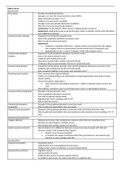Summary
Summary of Neuropsychology And Psychopharmacology Diseases
- Course
- Institution
Overview of all diseases listed in the “Neuropsychology” section. For each disease, the symptoms + affected brain regions are listed! Each exam always has a question where a symptom is given and where you have to give the disease yourself + indicate the brain region involved in a photo. So a ve...
[Show more]



